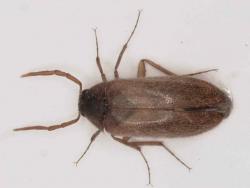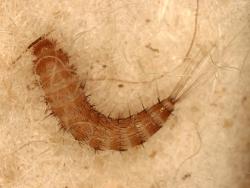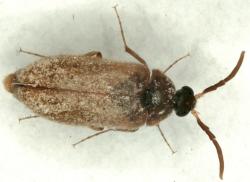Adult
Size
3.5 to 4 mm long
Aspect
Oval-shaped, elongate, convex toward the rear end.
Head slightly depressed at the level of the forehead and fairly distinct from the prothorax. One median ocellus on the forehead.
Elytra covered in a thick pubescence of flat yellowish bristles pointing toward the rear end.
Eleven-articled antennae in males and females. In females, the last 3 articles form a club. The last article is about 1.5-fold longer than the last-but-one, and the first 8 articles are nearly the same length as the last 3 together (the club). In males, antennae are much longer than in females, the last article alone is nearly the same length as the rest of the antenna.
Let us note that that Dermestidae’s peculiar antennae alone are enough to characterise the gender and the species.
Long, fine legs. Tarsi are at least the same length as the corresponding tibiae.
The first tarsal article is short: it is 1/5 of the length of the second article.
Colour
Dark yellowish to light brown


 Le dermeste de Bleuse
Le dermeste de Bleuse 


